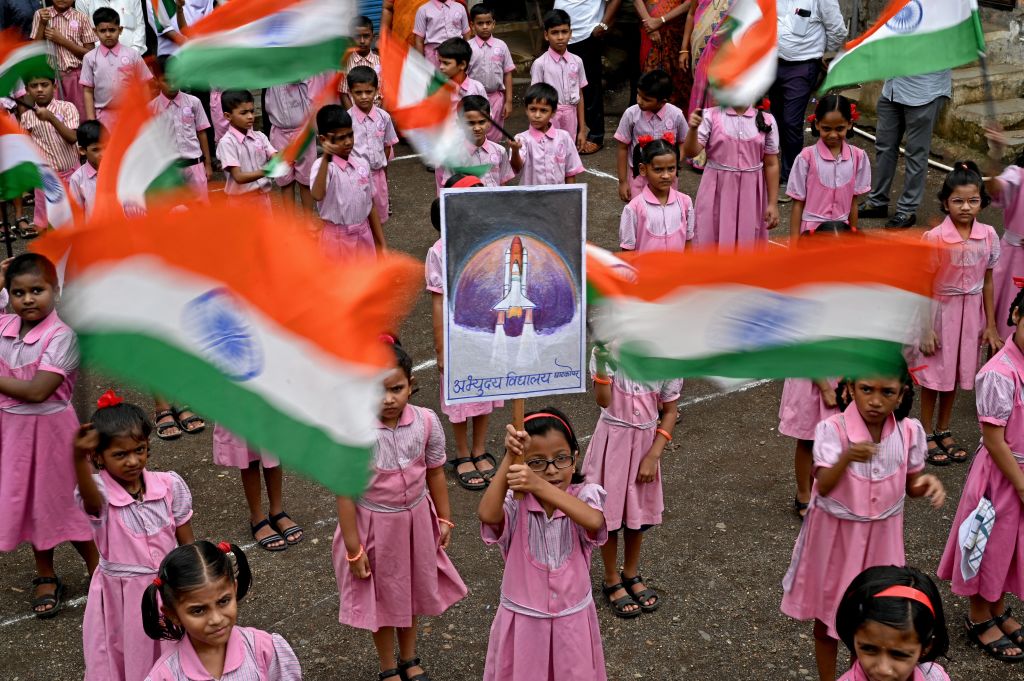
In 2014, after the Mars Orbiter Mission, known as Mangalyaan, made India the first Asian country to reach Mars orbit, and the first country ever to do so in its maiden attempt, the New York Times published a cartoon. Well-fed Westerners lounged inside a house labelled ‘Elite Space Club’, while India, represented by a turbaned peasant with a cow in tow, knocked on the door. It was a patronising and racist image, and it triggered a furore in India.
Now, the Chandrayaan-3 mission has made India the first country to land a lunar rover on the moon’s south pole, and a new cartoon began making the rounds. This time, the peasant and his cow are inside the house, now labelled ‘Moon South Pole’, while Americans, Russians and others line up at the door, rockets in hand, to request admission.
Indians are proud of their space program, for good reason. One of the world’s oldest and most ambitious, it arose from the Physical Research Laboratory, established in Ahmedabad in 1947, the year of India’s independence and brutal partition with Pakistan. In 1962, India’s visionary first prime minister, Jawaharlal Nehru, created the Indian National Committee for Space Research, marking the country’s official entry into space exploration. In 1969, INCOSPAR became the Indian Space Research Organisation.
Since then, ISRO has undertaken three missions to the moon (Chandrayaan-1, -2, and -3) in addition to the one to Mars, and created its own launch vehicles and satellites. India also launched its first solar mission, Aditya-L1, this month, and aims to have two or three people in low-earth orbit by the end of this year. (An Indian astronaut orbited the planet on a Soviet spacecraft in 1984.)
India owes its remarkable progress in space exploration in large part to Nehru’s dedication to developing a ‘scientific temper’ among the Indian people, his understanding of technology’s role in national advancement, and his faith in the country’s scientists. Though India was beset by poverty, illiteracy, food insecurity and disease, Nehru knew that it must—and could—aim for the stars.
Nehru’s doctrine of self-reliance, within tight budgetary constraints, had an enduring influence on India’s space program, exemplified by ISRO’s decision to take a slower, fuel-saving approach to the moon. Both Mangalyaan and Chandrayaan-3 were the least expensive ventures of their kind, costing about a tenth of equivalent NASA missions. They cost less even than Hollywood depictions of space missions: Mangalyaan cost less than the film Gravity, and Chandrayaan-3 less than Interstellar.
ISRO’s strengths extend well beyond frugality. With a focus on indigenous development of technologies and techniques, it has become a premier manufacturer of both launch vehicles and satellites, and a sought-after provider of low-cost launch services to other countries. Its Polar Satellite Launch Vehicle, with 24 successful flights, has a proven track record. In February 2017, India launched a record-breaking 104 (mostly American) satellites simultaneously on a single rocket.
How far we have come since the early 1960s, when a classic photograph by Henri Cartier-Bresson showed Indian rocket parts being transported on a bullock cart. And this is just the beginning: India’s space program is set literally to skyrocket. Experts predict that India could account for at least 10% of the global space economy in the next decade, up sharply from 2% currently.
India’s space program bolsters its internal development, having made important contributions even in seemingly unrelated areas, such as disaster management, education, health care, agriculture, fisheries and urban planning. Moreover, it serves India’s global diplomacy, enhancing the country’s credibility and influence. Those who once scoffed at the idea that a poor developing country aspired to send rockets into space must concede that India is a technological force to be reckoned with.
As India’s lander touched down on the moon, Prime Minister Narendra Modi wisely resisted parochial triumphalism and hailed the achievement as a victory for ‘all of humanity’. But he also correctly noted that the achievement ‘mirrors the aspirations and capabilities of 1.4 billion Indians’.
By showcasing its technological prowess, India’s space program reminds the world not only of its innovative capabilities, but also of its capacity to help shape solutions to global challenges in other areas, from cyberspace regulation to peacekeeping. India is showing the world that it can be a standard-setter, rather than just a follower of rules made by developed countries.
Chandrayaan-3’s success strengthens the confidence with which India faces the world. The country has spent the year presiding over the G20 and is an influential voice for the global south. But it has also been walking a geopolitical tightrope lately, playing leading roles in both the Quad (alongside Australia, Japan and the United States) and the Shanghai Cooperation Organisation (with Russia and China). While its relations with Western countries have never been closer, it shares a tense disputed frontier with China, and has an increasingly complicated relationship with its traditional partner, Russia.
How these relationships, and India’s global role more broadly, will evolve remains to be seen. But the country’s achievements in space undoubtedly strengthen its diplomatic hand, not least because of the respect they inspire in other countries.
Looking up at the sky after Chandrayaan-3, Indians can contemplate a glorious future. New horizons beckon.

